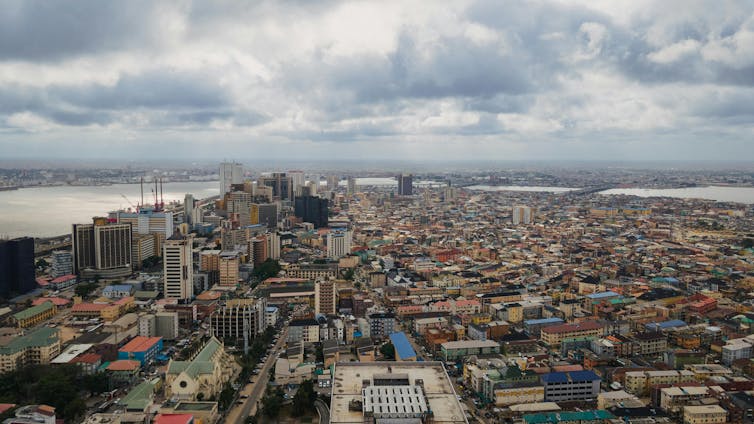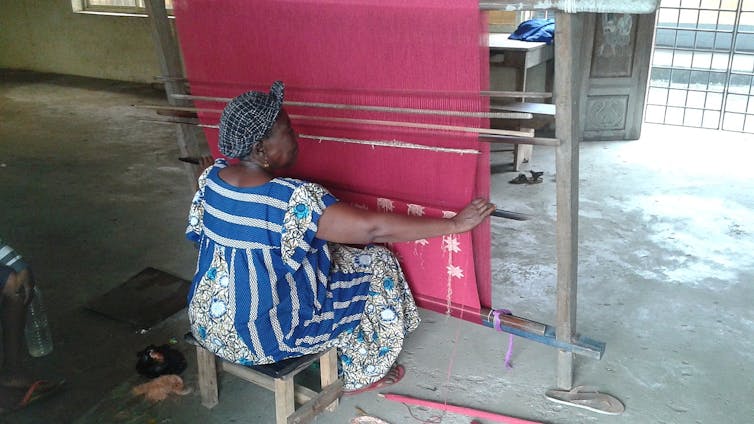African fashion has flourished in terms of creativity and innovation in recent years, and has attracted worldwide attention.
Designers and labels are driving out clothing that reflects African cities and how they interact with global trends. Think Ejiro Amos Tafiri and Mai Atafo from Nigeria, Christie Brown and Larry Jay from Ghana, Ikojin from Kenya, or Boyd from South Africa.
Cities such as Lagos, Accra, Marrakech, Nairobi and Johannesburg have become global fashion capitals. They are fashion production hubs that create styles that reflect cosmopolitanism. A vibrant mix of nationality.
Read more: West African fashion designers are the world’s leader when it comes to sustainable clothing production
Recent research focuses on how Lagos fashion reflects cosmopolitanism in bustling Nigerian cities. It reflects the encounter point between global and local influences.
Based on interviews with designers, I will explain how cosmopolitanism is produced through clothing and the gender dynamics that underpin it. African fashion production is drawn from local roots, but also corresponds to global social and cultural developments.
Cosmopolitan Africa
Cosmopolitanism is a global community that transcends borders. Many cultures inform big city fashion as they cook.
However, while conversations on cosmopolitanism have focused primarily on Western countries, Africa also has a long history of connections with other parts of the world through trade, transition and exchange of ideas.
African-American philosopher Kwame Anthony Appia argues that Western ideas of cosmopolitanism often assume a complete embrace of foreign cultures and ideals. However, among Africans, cosmopolitanism integrates the local community globally. He calls this rooted cosmopolitanism. In this case, it can be seen in a variety of ways in African society, such as urbanization and fashion.
Lagos
Lagos is Africa’s most populous city and is home to many migrants. It is a mixture of foreign and indigenous peoples from various cultural backgrounds, and I feel it makes sense to live as a Lagosian.

Ben Iwara/PexelCC by
I chose Lagos for my research because of the vibrant creative industry. Even a decade ago, Lagos was judged by one magazine as the fourth largest fashion city in the world. I interviewed 18 fashion designers who live and work there.
Local fabric, Western design for women
It turns out that Lagos fashion can be divided into two major trends: fabric and design. It is made from material clothing and vogue styles.
Local fabrics and repurposed fabrics (diplomacy-produced fabrics assimilated into Nigerian culture) are popular for women’s fashion today.
Local fabrics are hand-woven or dyed fabrics, and come from a variety of ethnic groups such as Aso Oke and Akwete.

Ekekeh Ubadire Obioma/Wikimedia CommonsCC by-sa
Popular fabrics are Ankara (wax print, from Indonesia), lace (a delicate, openwork fabric popular in traditional Nigerian attire), and George (a type of madras fabric popular among Nigerian Igbos).
Before the 2000s, the use of these fabrics was on both ends of the spectrum. Indigenous fabrics, laces and George were for social and cultural events. Ankara was for daily functional clothing, IRO (wrap skirt) and baba (a traditional three-piece design, mainly for married or married or elderly people).
The popularity of local fabrics in fashion today did not emerge from the vacuum. It was a designer’s choice, a social process of acceptance, and a government initiative.
Today’s designers consciously use local fabrics as a way of supporting and using them. Many were initially faced with rejection. Zena, a participant in my study, sold only two pieces of clothing in the first year of the business. She spent time convincing people that “this is good.”
And the interesting thing is, they are easy to wear and not expensive. But it took them a while for them to appreciate it.
Since the early 1990s, the Nigerian government has been working to promote local fabrics and locally produced clothing. In 2017, we approved the Nigerian Dress Days policy on Monday and Wednesday.
Today’s local fabrics are trending in women’s clothing fabrics, but the design trend is western. The designers use local fabrics in styles that have global appeal.
Still, they are conscious of maintaining reliability through either fabric, silhouette, or design concepts that resonate with culture.
According to Eji, her western designs still have African women in mind:
African women are not only found in Africa, but also around the world. I believe the world is more cosmopolitan. We have interracial marriages, we can borrow culture from anywhere, we can weave things.
Women’s fashion reflects the complexity of the Lagos Association and its openness to the global trends seeking to globalize local elements.
That’s the opposite for men
Lagos cosmopolitan men’s fashion is the opposite of women. The fabric trend is western. The design trend is local.
In Lagos, most men wear two or three pieces of “native”. For example, Buba and Sokoto are for regular wear. (Traditional two-piece tops and pants, usually from the same fabric.) Agbada is for special events. (Pants, top and loose fit, wide blurry robes.)
Participants in my study explained that the president’s ethnic background always influences men’s fashion trends. For example, former President Muhammadu Buhari, from the northern part of the country, popularising the wearing of Baba Riga (tops, pants and heavily embroidered overcover) by Hausa people.
Currently President Bora Ahmed Tinubu is expanding control of Agbada fashion as he is Yoruba. Men’s fashion emanates from the ethnic culture of the ruling president and depicts a unified cultural front adopted by most men regardless of their ethnicity. This allows for the inclusion of groups excluded from the dominant national culture.
Read more: Kofi Ansa leaves Ghana and becomes a world-renowned fashion designer – how his return to Japan boosted the industry
This study shows the openness to modernity of Nigerian fashion, and consciously implements styles from different regions of the world. However, this is not separated from the local area. As culture forms fade away (through cultural exchange) new forms are created and created locally. This is ultimately a celebration of Cosmopolitan in Lagos fashion and society.


